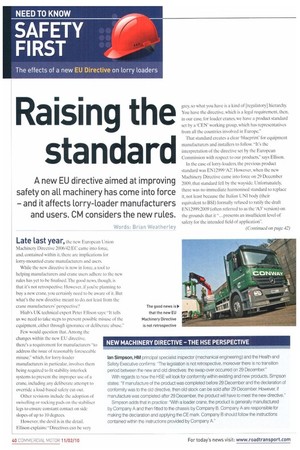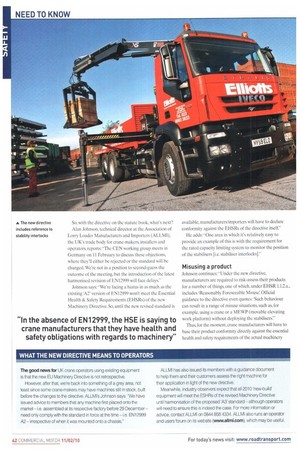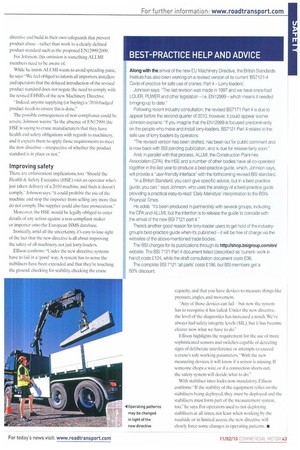Raising the standard
Page 40

Page 42

Page 43

If you've noticed an error in this article please click here to report it so we can fix it.
A new EU directive aimed at improving
safety on all machinery has come into force and it affects lorry-loader manufacturers and users. CM considers the new rules.
Words: Brian Weatherley Late last year, the new European Union Machinery Directive 2006/42/EC came into force, and, contained within it, there are implications for lorry-mounted crane manufacturers and users.
While the new directive is now in force, a tool to helping manufacturers and crane users adhere to the new rules has yet to he finalised.The good news, though, is that it's not retrospective. However, if you're planning to buy a new crane, you certainly need to be aware of it. But what's the new directive meant to do. not least from the crane manufacturers' perspective?
Hiab's UK technical expert Peter Ellison says: "It tells us we need to take steps to prevent possible misuse of the equipment, either through ignorance or deliberate abuse."
Few would question that. Among the changes within the new EU directive, there's a requirement for manufacturers to address the issue of reasonably foreseeable misuse," which, for lorry-loader manufacturers in particular, involves them being required to fit stability-interlock systems to prevent the improper use of a crane, including any deliberate attempt to override a load-based safety cut-out.
Other revisions include the adoption of swivelling or rocking pads on the stabiliser legs to ensure constant contact on side slopes of up to 10 degrees.
However. the devil is in the detail. Ellison explains: "Directives can he very grey, so what you have is a kind of [regulatory] hierarchy. You have the directive, which is a legal requirement, then, in our case, for loader cranes, we have a product standard set by a `CEN' working group, which has representatives from all the countries involved in Europe."
That standard creates a clear 'blueprint' for equipment manufacturers and installers to follow. "It's the interpretation of the directive set by the European Commission with respect to our products," says Ellison.
In the case of lorry-loaders, the previous product standard was EN12999 'A2'. However, when the new Machinery Directive came into force on 29 December 2009, that standard fell by the wayside. Unfortunately, there was no immediate harmonised standard to replace it, not least because the Italian UNI body (their equivalent to BSI) formally refused to ratify the draft EN12999:2009 (often referred to as the A3' version) on the grounds that it "...presents an insufficient level of safety for the intended field of application". So, with the directive on the statute book, what's next?
Alan Johnson. technical director at the Association of Lorry Loader Manufacturers and Importers (ALLMI), the UK's trade body for crane-makers, installers and operators, reports: -The CEN working group meets in Germany on 11 February to discuss these objections, where they'll either be rejected or the standard will he changed. We're not in a position to second-guess the outcome of the meeting, but the introduction of the latest harmonised revision of EN12999 will face delays."
Johnson says: "We're facing a hiatus in as much as the existing A2' version of ENI 2999 won't meet the Essential Health & Safety Requirements (EHSRs) of the new Machinery Directive. So, until the new revised standard is available, manufacturers/importers will have to declare conformity against the EHSRs of the directive itself."
He adds: -One area in which it's relatively easy to provide an example of this is with the requirement for the rated capacity limiting system to monitor the position of the stabilisers [i.e. stabiliser interlocks]."
Misusing a product Johnson continues: -Under the new directive, manufacturers are required to risk-assess their products for a number of things, one of which, under EHSR 1.1.2.a., includes 'Reasonably Foreseeable Misuse Official guidance to the directive even quotes: 'Such behaviour can result in a range of misuse situations, such as, for example, using a crane or a MEWP (movable elevating work platform) without deploying the stabilisers:"
Thus, for the moment, crane manufacturers will have to base their product conformity directly against the essential health and safety requirements of the actual machinery directive and build in their own safeguards that prevent product abuse — rather than work to a clearly-defined product standard such as the proposed EN12999:2009.
For Johnson, this omission is something ALLMI members need to be aware of.
While he insists ALLMI wants to avoid spreading panic, he says: "We feel obliged to inform all importers, installers and operators that the delayed introduction of the revised product standard does not negate the need to comply with the revised EHSR's of the new Machinery Directive.
"Indeed, anyone supplying (or buying) a `2010-badged. product needs to ensure this is done."
The possible consequences of non-compliance could be severe. Johnson warns: "in the absence of EN12999, the HSE is saving to crane manufacturers that they have health and safety obligations with regards to machinery, and it expects them to apply those requirements to meet the new directive — irrespective of whether the product standard is in place or not."
Improving safety
There are enforcement implications, too. "Should the Health & Safety Executive (HSE) visit an operator who's Just taken delivery of a 2010 machine, and finds it doesn't comply:* Johnson says. "it could prohibit the use of the machine and stop the importer from selling any more that do not comply. The supplier could also face prosecution."
Moreover, the HSE would be legally obliged to enter details of any action against a non-compliant maker or importer onto the European ISMS database.
Ironically, amid all the uncertainty, it's easy to lose sight of the fact that the new directive is all about improving the safety of all machinery, not just lorry-loaders.
Ellison confirms: "Under the new directive, systems have to fail in a 'good' way. A system has to sense the stabilisers have been extended and that they're touching the ground, checking for stability, checking the crane capacity, and that you have devices to measure things like pressure, angles, and movement.
"Any of those devices can fail — but now the system has to recognise it has failed. Under the new directive, the level of the diagnostics has increased a notch. We've always had safety integrity levels (SIL). but it has become clearer now what we have to do."
Ellison highlights the requirement for the use of more sophisticated sensors and switches capable of detecting signs of deliberate interference or attempts to exceed a crane's safe working parameters. "With the new measuring devices, it will know if a sensor is missing. If someone chops a wire, or if a connection shorts out, the safety system will decide what to do."
With stabiliser inter-locks now mandatory, Ellison confirms: "If the stability of the equipment relies on the stabilisers being deployed. they must he deployed and the stabilisers must form part of the measurement system, 41 Operating patterns too," he says. For operators used to not deploying may be changed stabilisers at all times, not least when working by the in Light of the roadside or in limited access, the new directive will new directive clearly force some changes in operating patterns. •




































































































































